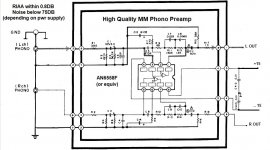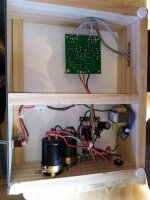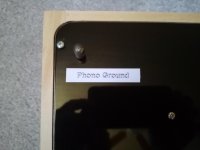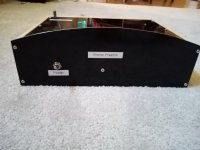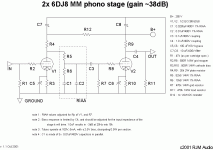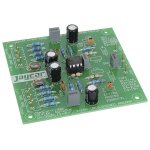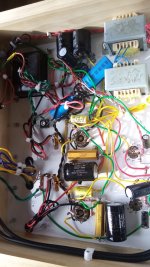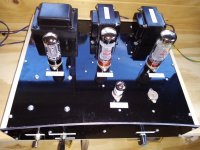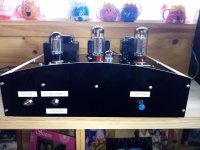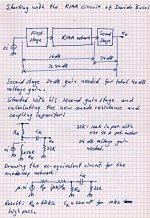Ok since I have both my 6l6 and el34 tube amps running were I want them I'm not on the hunt for a simple but good sounding Phono Preamp . So is it best to run a Phono pre amp tube or soild state with my tube amps???
Simple.
Great performance.
Compact.
Attachments
Thanks to everyone that has help me decide on what I will do, I m building 2 phono preamps 1 solid state the other tube. I have mod this Jaycar kit and got it working better the highs that scream at you has gone and the lows has slightly increased. But still room for improvements so I will build one from scratch, see attach in which tube phono preamp I have decided on building this tube one simply because I love the sound of 6DJ8 give, if it fails then a have a second choice.
Attachments
No I have no hum or interference, the tube preamp will be mounted on black aluminum and wood sides black aluminum front back.
So, do you have something against lining the inside of that wood frame with sheet metal or foil, to surround comepletely the internals?
This is what I picture to "lined with foil"
The point I was trying to make was that any small-signal equipment like a phono preamp and such really needs to be shrouded in a metallic casing to eliminate any possible outside influences.
Particularly tube equipment with high impedences.
While a nice wooden "box" or enclosure is fine, to just plop stuff in it without shielding is simply doing a poor job of designing.
And I mean total shielding, not just a fancy metal dress panel.
Some tubes also benefit from using a shielded style tube socket, with a cylindrical shroud cover.
This was, and is, the way proper design always involved.
Now anyone can argue the case with me, but the proof is easily found by looking at mass marketed equipment.
Take a look at a McIntosh preamp, a Fisher, H/K...... any well designed equipment.
I've got a Heathkit SS amp from around 1980 with two wooden side panels.
Curiously, depending on where it was used, there was a slight background "hum" or buzz when cranked up without signal.
I lined the inside of each side panel with aluminum flashing, hum is gone..... dead silent.
Last edited:
Oh I got your point, just that foil is cheap/ghetto/ugly.
Many 70's and 80's equipment were built on a metal frame installed into a wooden sleeve with a cardboard bottom inclusing the Marantz 2215.
I have a Sansui tuner with plastic sides and a cardboard bottom.
FWIW, I design all of my stuff in a metal chassis because it's easier to work than wood IMHO. I can't punch wood.
A simple faraday cage made from wire mesh would provide the necessary shielding, too.
Many 70's and 80's equipment were built on a metal frame installed into a wooden sleeve with a cardboard bottom inclusing the Marantz 2215.
I have a Sansui tuner with plastic sides and a cardboard bottom.
FWIW, I design all of my stuff in a metal chassis because it's easier to work than wood IMHO. I can't punch wood.
A simple faraday cage made from wire mesh would provide the necessary shielding, too.
So, do you have something against lining the inside of that wood frame with sheet metal or foil, to surround comepletely the internals?
Why I don't need it even my amps are built with timber sides back but everything is mounted on black aluminum sheeting with NO hum or interference. see attach
Attachments
Why I don't need it even my amps are built with timber sides back but everything is mounted on black aluminum sheeting with NO hum or interference. see attach
Amps....... are a different animal.
They don't have the "sensitive"circuitry like a front end preamp does, and are far less prone to external interferences.
I get the feeling that you're somehow against my suggestions.
And that's fine.
After all, I'm not talking out of my azz, being in the electronics industry professionally for over 45 years.
But you go ahead with your project.
By the way, with your construction, with the exposed wood and having closely placed parts near it, it would never pass Safety Codes here in the USA.
Last edited:
Wiseoldtech I'm not here to argue with what you have put forward, I understand your aim here about metal vs timber, yes have I got components to close to the timber sides? Yes. A better thought out chassis would be the way to go, I simply disagree with you on hum and interference that is all, I don't suffer from any of that so why would I change it to suit what you want me to do? I too have been in the electronics electrical for many years, I have built my whole home on off grid solar, myself all my own design I know all about voltage that can kill and how wood and electricity don't mix.I also know metal and electricity don't mix have a live wire fall off or simply come loose inside the metal chassis and you touch it next minute you are outside the pearly gates, I just simply disagree with you on the principal of not having metal surrounds in my phono preamp will not stop interference and hum. You have a great day 
Last edited:
Had two Fostex and 2 Tascam multitrackers...all platics and tin foil on paper for shielding...each of them handling 4mike , 4 tape-head inputs(60db gain each ) based heavily on NJM2068 op-amps... Tube circuits, much more difficult to shield and prone to lower PSRR, CMRR, EMI, etc...Simple op-amps...no iron needed around.Fostex X30 (MT Nov 87)
....I have built my whole home on off grid solar....
Grid power is AC hum. Solar cells make DC, zero hum.
Hum comes from living too close to "civilization".
People who live in cities with utilities forget/don't-know what it is like for me and you, way out in the woods and prairies.
Yes best place to be in this crazy world we live in, I run a 48v off grid solar system and put a decent earth rod in 1.5m deep which gives me a good earth, having the pure sine wave inverter earthed as well I have no problems with hum, even my 6500w pure sine wave generator gives no hum. I built a home theater room and every electrical equipment runs from the pure sine wave inverter with no spikes yet on utility power here in most of Australia your power voltage goes on a good day 235v to a bad day of 246v, but hey "Qualified" electrical inspectors say nothing wrong with the voltage!!!!
Not questioning anyone, just responding to your remark that you cannot find anything that was not carefully designed.
Perhaps there is a language/translation issue with the word "careful" here, but in the normal meaning of the word, that statement doesn't make sense. No offense. Would you want me to perform brain surgery on a loved one if I'm "careful"? Would you not be more interested if I'm competent?
Regardless, if you examined his design closely and it was done competently in your opinion, perhaps you can explain his choice of the 22k load, 22uF cap and I might have a couple other questions after that
Starting from calculating the voltage gain from the input of the first stage to the input of the second stage using Bucci's LTspice file, this was 16dB so an extra 24dB voltage gain is necessary for the second stage to obtain 40dB voltage gain which is in my opinion sufficient to get a 500mVrms output when using a MM cartridge which I use in my RIAA design using transistors (active RIAA circuit).
The calculated values for the anode resistor and coupling capacitor differ substantially from the Bucci's values:
Ra=68k and Ck=220nF (10Hz high pass).
Attachments
Not questioning anyone, just responding to your remark that you cannot find anything that was not carefully designed.
Perhaps there is a language/translation issue with the word "careful" here, but in the normal meaning of the word, that statement doesn't make sense. No offense. Would you want me to perform brain surgery on a loved one if I'm "careful"? Would you not be more interested if I'm competent?
Regardless, if you examined his design closely and it was done competently in your opinion, perhaps you can explain his choice of the 22k load, 22uF cap and I might have a couple other questions after that
Well, still curious over here. Always eager to learn
Well thanks for all inputs, I have 3 phono preamps in mind, what do you think of the three which if any would be a nice build?
None of those. Eli Duttman's is a far better choice. Or an EAR clone.
If you build an EAR 834p clone, swap out the last tube for a mosfet follower like Eli does.
I should build Eli's RCA Redux RIAA preamp. A lot has been written about it, but I've not heard one yet. I've resisted building it because I'm not sure about the grid leak bias 2nd stage. What does grid current do to the loading on the EQ network? Does the input impedance of that 2nd stage change with signal level? Or am I not understanding how grid leak (aka contact potential) bias works?
- Home
- Amplifiers
- Tubes / Valves
- Tube Phono or Solid State
